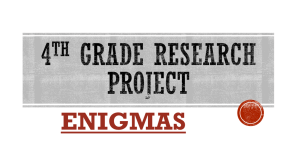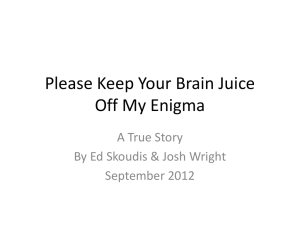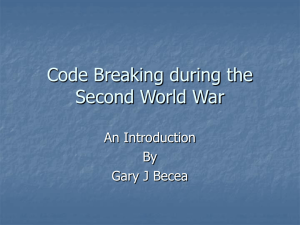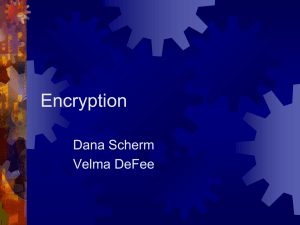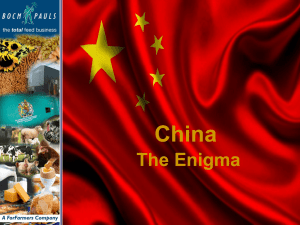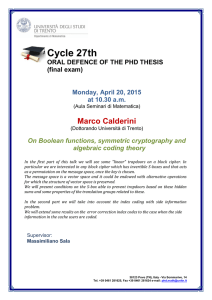to this presentation as a Powerpoint file
advertisement
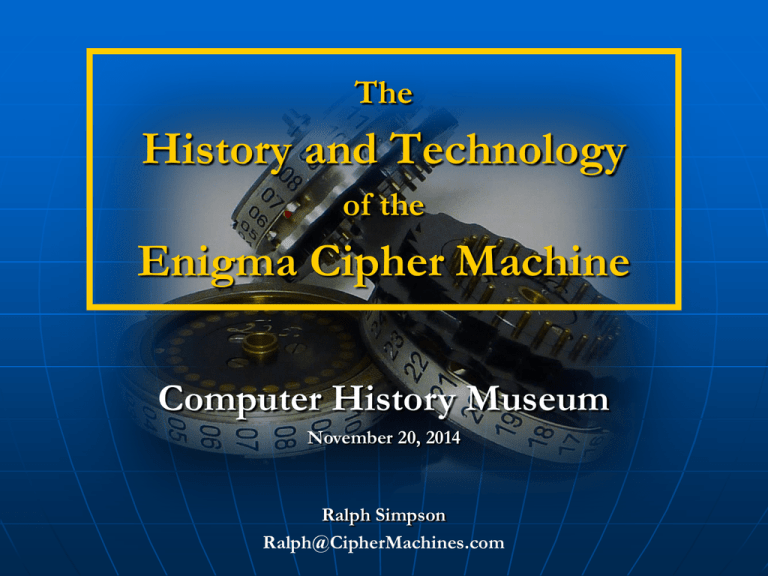
The History and Technology of the Enigma Cipher Machine Computer History Museum November 20, 2014 Ralph Simpson Ralph@CipherMachines.com Agenda Early history of rotor machines Controversy of Enigma invention Enigma technology Key length of the Enigma Shortcomings of the Enigma Significance of Enigma in WW2 Breaking the code Beginning of modern computing The Technology and History of the Enigma Cipher Machine 2 WW1 - Radio made most ciphers obsolete Proliferation of radios in WW1 highlighted the need for a new cipher technology Many ciphers had shortcomings when 100’s of messages are captured using the same key Cipher technology was manual and error-prone Confederate Vigenère Wheel The Technology and History of the Enigma Cipher Machine US Army M-94 Cipher Wheel 3 Invention of Rotor-Based Cipher Machines Enigma was one of four cipher machines with electro-mechanical rotors invented in 4 different countries between 1917-1919 Edward Hebern USA 1917 Hugo Koch Holland 1919 The Technology and History of the Enigma Cipher Machine Arthur Scherbius Germany 1918 Arvid Damm Sweden 1919 4 Enigma Invention Arthur Scherbius Germany Hugo Koch Holland German Navy bought Enigma in 1926, Army in 1928 In 1927, Enigma inventor Scherbius curiously bought the rights to Koch’s patent, paid 600 Dutch guilders (~$350) Scherbius had the earlier, and almost identical patent Koch died in 1928 Scherbius died in 1929 in a horse carriage accident, not knowing the role his invention would have in history The Technology and History of the Enigma Cipher Machine 5 History Rewritten in 2003 2003 discovery: electro-mechanical rotor cipher was invented in 1915 by 2 Dutch naval officers Theo van Hengel Dutch Navy suppressed this patent until Nov. 1919, weeks after Koch’s patent was granted RPC Spengler The patent attorney for the 2 Dutch naval officers was the brother-in-law of Hugo Koch! Koch collaborated with Scherbius, and their patent drawings were identical to the Dutch naval officer’s Now it is recognized that van Hengel and Spengler were the true inventors of the Enigma machine The Technology and History of the Enigma Cipher Machine 6 Enigma Technology Typewriter style cipher machine was a major advance in ease of use and cryptologic strength Innovation was the electro-mechanical rotors to encipher / decipher messages Pressing a key causes the rotors to turn, giving a new cipher algorithm for each letter in a message Electric pathway goes from keyboard plugboard rotors reflector rotors plugboard, then it lights up a bulb There is no printing capability, so the message must be written down The Technology and History of the Enigma Cipher Machine 7 Keyboard QWERTZ keyboard with only 26 letters - no numbers, space bar, etc. Pressing key first rotates 1 to 3 rotors then lights up a bulb Each letter is encrypted 7 to 9 times, the key changes for each letter Note the serial # plate below the “V” The Technology and History of the Enigma Cipher Machine 8 Plugboard German military added the plugboard to commercial Enigma in 1930, greatly increasing cryptologic strength In WW2, Germans always used 10 cables, switching 20 of 26 letters instead of varying # of cables from 0-13 Reduced key length by a factor of 4, but simplified operations The Technology and History of the Enigma Cipher Machine 9 Rotors Notch by “04” causes the rotor to its left to turn 3 rotors out of 5 available are changed daily, giving 5 X 4 X 3 = 60 possible positions for the 3 rotors Each rotor is set to a beginning alphabetic character, giving 263 = 17,576 possible settings Notch on each rotor sets turnover point for the rotor to its left, giving 262 = 676 possibilities (notch on leftmost rotor has no effect) Later in WW2, the German Navy developed a 4 rotor Enigma and added 3 new rotors to the 5 available The Technology and History of the Enigma Cipher Machine 10 Reflector Reflector swaps pairs of letters If “A” was enciphered to a “G”, then “G” was enciphered as “A” The electrical signal goes through the 3 rotors, then the reflector and back again through the 3 rotors Reflector is to the left of the rotors (with red “B”) Reflector enables Enigma to encrypt / decrypt with the same key settings Reflector design meant no plaintext letter could encrypt to itself This was a major design flaw and was exploited by the Allies Finding cribs (expected words in an enciphered message) was aided by German military precision and the reflector design The Technology and History of the Enigma Cipher Machine 11 Light Bulb Panel Keyboard, plugboard and light panel all follow QWERTZ format Only method of output - no printing capability Small light bulbs light up a letter, which must be written down Latches hold plastic filter for use in sunlight Operated by 4.5 volt battery or transformer from 220V plug The Technology and History of the Enigma Cipher Machine 12 Wiring Diagram Reflector Reflector & Rotors Light Panel Middle Rotor Right Rotor 6 7 8 4 3 2 Entry Drum # = # times enciphered 5 Q W A E S R D T F Z G U H I J O K P Y X C V B N M L Q W E R T Z U I O A Keyboard Plugboard Left Rotor S D F H G J K P Y X C V B N M L Q W E R T Z U I O A P S Y The Technology and History of the Enigma Cipher Machine D X 9 F C G V J H B N 1 M K L 13 Key Length of the Enigma Enigma has theoretical maximum number of settings (or keys) of 3 X 10114, far more than the number of atoms in the universe (1080) Germans accepted operational tradeoffs which reduced the key length to the still astronomical number of 1023 A key length of 1023 is equivalent to a 77 bit key, better than the 56 bit DES standard of 1976-2002 A key length of 1023 means 100,000 operators, each checking one key setting every second would take twice the age of the universe to break the code The Technology and History of the Enigma Cipher Machine 14 Nazi Procedures for the Enigma Daily keys (settings for rotors and plugboard cables) were sent in a code book each month (longer for U-boats) Using the daily key, operators first sent a new key, then the text of the message in this new key – nullifying letter frequency analysis The new key specified the 3 rotor positions, and was sent TWICE Some operators used the same keys for each message, such as girlfriends initials, giving clues to solve the code Polish code-breakers exploited this shortcoming until 1939, when the Nazis sent the key only once The Technology and History of the Enigma Cipher Machine Using Enigma in the field 15 Shortcomings of the Enigma The reflector design allowed encryption and decryption with the same setting, but also ensured no letter encoded to itself Rotors had regular “odometer” movement Multiple notches used to make odometer stepping more complex was used on naval Enigma only Greatest shortcomings were lax operator procedures Strength of Enigma design gave Germans complete confidence in its security, even when faced with evidence of compromise The Technology and History of the Enigma Cipher Machine “Panzer General” Heinz Güderian on communications truck with Enigma machine 16 German Secrets of the Enigma Notice anything unusual about this Enigma? Another Nazi propaganda picture of Enigma White cover over the plugboard Enlargement of Enigma from previous slide Germans wanted to keep secret the military addition of a plugboard Even German allies, Italy and Japan, received Enigma machines without the plugboard The Technology and History of the Enigma Cipher Machine 17 Polish Success in Decoding Enigma In 1932, Polish cryptologists reverse engineered the Enigma Enigma code was still not broken until the French bribed a German official to get keys German official, Hans-Thilo Schmidt, was later caught and executed Polish code-breakers could now exploit the double sending of the key – breaking the code in March 1933 Marian Rejewski Polish cryptographer Poles made the Bomba – 6 Enigma machines in series to speed the checking of codes for the 6 combinations of 3 rotors Poles successfully decoded Enigma messages until 1939, when the Germans quit sending the key twice and added 2 new rotors Poles finally disclosed their code-breaking success to Britain and France just before Germany invaded Poland on Sept. 1, 1939 The Technology and History of the Enigma Cipher Machine 18 British Effort in Breaking the Code In 1939, UK began a major decoding effort in Bletchley Park, employing 11,000 people Effort led by Alan Turing, who built the Bombe - 36 Enigmas in series Bletchley Park Mansion to check settings Many settings were manually eliminated and only the remaining settings checked by the Bombe – brute force wouldn’t work Army and Luftwaffe messages were routinely decoded, the Naval Enigma was the greatest challenge British only acted on intelligence that could be uncovered from traditional sources (spies, direction finding, radar, traffic analysis) The Technology and History of the Enigma Cipher Machine 19 U-Boat Peril Before the US entered the war, U-boats decimated Allied shipping, sinking about 60 ships per month U-boats roamed freely throughout Atlantic, forming “wolfpacks” to efficiently destroy convoys of supply ships for the UK Nazi strategy was to blockade the UK, expecting a quick surrender Naval Enigma was initially the same as the Army, but later more complex versions were used with more rigorous procedures Naval Enigma messages were completely secure until May, 1941 “The only thing that ever really frightened me during the war was the U-boat peril” - Winston Churchill The Technology and History of the Enigma Cipher Machine U-Boat 20 U-110 The first U-boat boarded and code books recovered was from U-110 in May 1941 Captain died scuttling U-boat U-110 was sunk by British so Germans didn’t realize their codes were compromised Sinking of U-110 This single act was the turning point in the Battle of the Atlantic Captain of U-110 Fritz Julius Lemp Enigma operator in U-110 The Technology and History of the Enigma Cipher Machine HMS Bulldog – British destroyer captured U-110 21 Bombe – the Beginning of Computing Alan Turing: Father of Computing US Bombe Polish cryptoanalysts named their electro-mechanical codebreaker the Bomba for an ice cream treat, British called it a Bombe 210 Bombes were built in the UK, all were destroyed after WW2 US employed NCR to build a faster version of the Bombe to decode the 4 rotor naval Enigma – 121 were built By the end of the war, the naval code was deciphered within 12 hours and the rest of the day’s messages were read in real time The Technology and History of the Enigma Cipher Machine 22 Colossus Colossus – world’s first programmable digital computer Named because of its overwhelming size, including 1600 vacuum tubes Designed by Tommy Flowers with help from Alan Turing in 1943 Colossus – note paper tape reels on right Colossus was used to break Nazi Lorenz teletype cipher, not the Enigma machine Total of 11 Colossi were built, all destroyed after the war CHM has tape pulley from an original Colossus The Technology and History of the Enigma Cipher Machine 23 Battle of the Atlantic After breaking the Naval Enigma code, British selectively protected some ships US bombing of U-117 – Aug. 1943 British knew when U-boats would surface for supplies, so they pretended to “accidentally” find and destroy them In 1942, a 4th rotor was added to the Naval Enigma and 8 rotors were issued instead of 5 - making it more difficult to decipher An operator mistakenly sent the same message using old and new Enigmas, giving valuable clues to the new rotors and reflector It was discovered that unarmed weather trawlers carried the Enigma and codes, an easy target for additional code books Early U-boat success turned to failure, 725 of 1155 U-boats and 82% of 35,000 sailors never returned from sea Some estimate breaking the Enigma shortened WW2 by 2 years The Technology and History of the Enigma Cipher Machine 24 Enigma After WW2 The Enigma decoding success was a closely guarded secret, even after the war Code-breaking success was not revealed until 1974, despite 11,000 people working on the effort in Bletchley Park, plus thousands more in the US US and UK encouraged use of Enigmas by other countries, including allies, reading their secrets for 3 decades Some Bombes were not destroyed, to decipher messages from countries still using Enigmas Up to 30,000 Enigmas were manufactured, most destroyed during or just after the war Today, fewer than 350 Enigmas are known to exist, about half in private collections The Technology and History of the Enigma Cipher Machine 25 Download this Presentation CipherMachines.com/enigma.ppt The Technology and History of the Enigma Cipher Machine 26 Addendum Calculations showing the maximum number of settings both theoretically and as practiced by the Nazis The Technology and History of the Enigma Cipher Machine 27 Plugboard Settings The # of possible plugboard settings is a function of 3 variables: 1. # plugboard cables, p, can be from 0 to 13 2. # of groupings of possible letters (2p letters out of 26) 3. # interconnections of p cables within the group of letters chosen 1. # plugboard 2. # groupings of letters 3. # interconnections Total # possible settings cables 26! / ((2p!) X (26-2p)!) (2p-1) X (2p-3) X (2p-5) X …X 1 (Column 2) X (Column 3) 0 1 1 1 1 325 1 325 2 14,950 3 44,850 3 230,230 15 3,453,450 4 1,562,275 105 164,038,875 5 5,311,735 945 5,019,589,575 6 9,657,700 10,395 100,391,791,500 7 9,657,700 135,135 1,305,093,289,500 8 5,311,735 2,027,025 10,767,019,638,375 9 1,562,275 34,459,425 53,835,098,191,875 10 230,230 654,729,075 150,738,274,937,250 11 14,950 13,749,310,575 205,552,193,096,250 12 325 316,234,143,225 102,776,096,548,125 13 1 7,905,853,580,625 7,905,853,580,625 Total The Technology and History of the Enigma Cipher Machine 532,985,208,200,576 28 Rotor Settings The internal wiring of each rotor could be constructed in 26! different combinations. Since 3 rotors are used, the number of combinations when selecting 3 rotors out of 26! are: • 26! X (26!-1) X (26!-2) = 65,592,937,459,144, 468,297,405,473,480,371,753,615,896,841,298, 988,710,328,553,805,190,043,271,168,000,000 Each of the 3 rotors could initially be set to any letter: • 26 X 26 X 26 = 17,576 The right-most rotor advances one letter after each key is pressed, the second and third rotors advance one letter after a full revolution of the rotor to its right. The setting for the notch to enable this was also changeable to any letter of the alphabet: • 26 X 26 = 676 (Note: notch on left-most rotor has no effect) The Technology and History of the Enigma Cipher Machine 29 Reflector Settings The reflector scrambled the letters in pairs so it could encrypt and decrypt The letter “A” could be switched to any of the 25 remaining letters, the next letter could be switched to any of the 23 remaining letters, and so on. Notice this result is the same as using 13 plugboard cables, since all letters are paired (see chart on page 22) • 25 X 23 X 21 X … X 1 = 7,905,853,580,625 The Technology and History of the Enigma Cipher Machine 30 Total Theoretical Number of Settings The total theoretical number of Enigma settings is thus the product of the 5 items on the previous 3 slides, or… • 3,283,883,513,796,974,198,700,882,069,882,752,878, 379,955,261,095,623,685,444,055,315,226,006,433,615, 627,409,666,933,182,371,154,802,769,920,000,000,000 • Or 3.28 X 10114 This number is far greater than the total number of atoms in the observable universe (1080) The Technology and History of the Enigma Cipher Machine 31 Theory vs. Practice The theoretical number of Enigma settings was not achieved in practice by the Germans, the number of settings the Allied Forces encountered for the standard 3 rotor enigma: • 10 plugboard cables were always used, reducing errors and the possible combinations to 150,738,274,937,250 • Only 5 of 26! possible rotors were issued and known by Allies, so selecting 3 out of 5 is 5 X 4 X 3 = 60 • The initial settings of the rotors and the positions of the notches remain the same at 17,576 and 676 • Reflector setting was known and remained unchanged = 1 • The product of the above numbers is: 107,458,687,327,250,619,360,000 or 1.07 X 1023 To test 1023 key settings, 100,000 operators each checking one setting every second would take twice the age of the universe to break the code The Technology and History of the Enigma Cipher Machine 32

